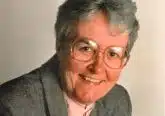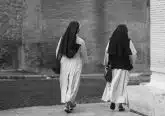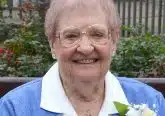100 years! Celebrating a century of community at our home on Salem Avenue
On Aug. 28, 1923, Sisters of the Precious Blood were welcomed with the pealing of bells upon their arrival at the new motherhouse on Salem Avenue.
Founded in 1834 in Switzerland by Maria Anna Brunner, Sisters of the Precious Blood first arrived in the U.S. in 1844 when three Sisters journeyed to northern Ohio to minister to German Catholic immigrants. Over the next 12 years, the religious community established convents throughout northern Ohio and Indiana; for nearly 80 years, the site of their motherhouse was Maria Stein in Mercer County.
By the early 1920s, Mother Emma Nunlist, the Mother General of the Sisters of the Precious Blood, was familiar with Dayton because the Sisters were already involved in ministry there. She felt that they needed to be closer to the amenities the city could provide, including health care and education. She also thought that being close to the city would allow the Sisters to find more volunteers to help with perpetual adoration of the Eucharist, a hallmark of the Sisters’ lived vocation since their founding.
She purchased 75 acres of farmland two miles north of Dayton, and construction began.
“The feast of St. Augustine, August 28, 1923, will go down in the annals as a memorable day for the community, since it marks the departure of the Sisters from the old motherhouse to the new,” reads the community’s historical record. “Knights of Columbus of Dayton offered to transport the Sisters to Salem Heights, where they were welcomed with the pealing of bells and the greetings of the Sisters who had arrived earlier.”
The motherhouse on Salem Avenue now houses the Maria-Joseph Nursing and Rehabilitation Center. The Sisters’ central house is located next door in the building known as Salem Heights. It comprises a retirement center, chapel and gathering spaces for the community.
Over the past century, Sisters of the Precious Blood have been active in numerous ministries in the Dayton area, including education, parish ministry, food and domestic service, health care and social justice. Our Congregation evolves alongside the changing needs of our surrounding communities; we observe the signs of the times and serve wherever and however we are needed.
As we reflect on our history, we honor our foundress Maria Anna Brunner, and we remember with love and gratitude those Sisters who came before us, who gave their lives in ministry to communities in Dayton and beyond. And we remain firmly rooted here on Salem Avenue, in the place that we are proud to call “home.”
Join us as we look back on the journey of love that brought us here.
1891: The Sisters begin ministry at St. Joseph Orphanage (now the site of the Glen at St. Joseph). The orphanage was founded by the Society of St. Joseph in 1849 to care for children whose parents died during the cholera epidemic.
1893: The Sisters begin ministry at St. Mary School. The parish was founded in 1859 for German Catholics in east Dayton.
1898: The first issue of the Dayton Daily News is published.
1912: Mother Emma Nunlist purchases 75 acres of land two miles north of Dayton for a new Motherhouse.
1913: The Sisters begin ministry at Holy Name School. The parish was founded in 1907 by the Holy Name Society for Hungarian Catholics in Dayton.
1913: The Great Dayton Flood lasts for several days in March.
1921: The Sisters begin ministry at Resurrection School.
1923: The Sisters move their motherhouse to Dayton from Maria Stein, Ohio.
1929: The Dayton airport is dedicated.
1930: The Sisters found the Maria Joseph Home for the Aged.
1930: The Dayton Art Institute is dedicated.
1932: St. Mary Parish numbers over 900 families.
1946: The Sisters begin ministry at St. Rita School. The parish was founded in 1922 for Catholics in northwest Dayton.
1948: Sisters donate land for what would become Precious Blood Parish. The first Mass is held in the Motherhouse basement.
1948: Wright and Patterson fields consolidate as Wright-Patterson Air Force Base.
1949: Precious Blood School opens with 94 students and two Sister teachers.
1950s: Construction of U.S. 35 begins, causing families to move to the suburbs and lowering parish membership at St. Mary Parish.
1951: The Sisters begin ministry at Assumption School.
1953: Esther Price opens her candy shop on Wayne Avenue.
1961: The Sisters begin ministry at Carroll High School. The faculty was composed of four priests and members of six congregations of women religious. CPPS Sisters taught in the science, math and home economics departments.
1961: Holy Name School is discontinued due to the lack of parishioners in the neighborhood.
1966: Race riots sparked by the drive-by shooting of an unarmed Black man on West Fifth Street cause many families and businesses to leave the neighborhood, and Resurrection parish numbers drop.
1967: The Sisters leave ministry at St. Joseph Orphanage due to a lack of available Sisters.
1970: Four years after the race riots, vigorous changes in Resurrection School’s curriculum and parish programs help raise enrollment to over 900 students.
1971: St. Mary School closes.
1971: Trotwood is incorporated as a city.
1979: Most Sisters leave ministry at Precious Blood School due to a lack of available Sisters, but some continue to live in the convent until 1995.
1979: The Sisters move to the former Maria Joseph Home for the Aged, which now serves as their Central House.
1970s: The Assumption Parish population drops due to an exodus from the Greenwich Village neighborhood of northwest Dayton. Assumption, St. Agnes and St. James schools consolidate and become Dayton Catholic Elementary School (closed in 2006). Sister Martha Schock was the last to leave in 1978.
1981: Sister Dorothy Kammerer and several other Sisters found the Community Help Center, a store located at the corner of Riverview and Summit (now Paul Laurence Dunbar) avenues. It aimed to provide food to low-income people in the neighborhood. While the store remained open for only eight months, it catalyzed several other lasting efforts in the area.
1982: Sisters leave ministry at St. Rita School due to a lack of available Sisters.
1983: Sister Maryann Bremke becomes the vice principal of Carroll High School, where she remained until 1999.
1984: Sisters leave ministry at Resurrection School due to a lack of available Sisters.
1984: Sister Dorothy Kammerer and Joe Bettman found the House of Bread to offer a hot, nutritious meal to those in need seven days a week. Their mission continues, aiming to “prevent hunger and serve as a bridge to beneficial community resources.”
1988: Sister Dorothy Kammerer founds The Other Place to help the homeless find places to stay during the day. In 2010, The Other Place changed its name to Homefull, which continues to take “a comprehensive approach to addressing poverty in general, which is the root cause of homelessness.”
1989: Sister Rose Helene Wildenhaus and Dick McBride found the St. Mary Development Corporation. The Corporation’s mission is to build “affordable apartment communities” and connect “residents to life-changing services that help them thrive.” The Corporation’s programs and building projects have provided support to over 5,000 people.
1992: Sister Anne Schulz becomes the principal of Precious Blood School, where she remained until 1997.
1993: Sister Dorothy Kammerer initiates Interfaith Action for a Violence-Free America, now called the Community Homicide Prayer Vigils. The group holds prayer vigils for area homicide victims and their families.
1995: Sister Mary Garascia serves as the pastoral administrator of Assumption Parish until 1998.
1995: The Dayton Accords are held at Wright-Patterson Air Force Base, ending the Bosnian War.
2002: Sister Rosemary Lindemann taught at St. Rita until 2009.
2011: Sisters Maryann Bremke and Helen Weber found the Brunner Literacy Center, which “provides flexible learning to meet the individual needs of adult students in pursuit of their personal or professional education.”
— Story by Sarah Aisenbrey













